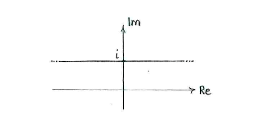Lösung 3.2:2e
Aus Online Mathematik Brückenkurs 2
(Unterschied zwischen Versionen)
K |
K (Robot: Automated text replacement (-{{Displayed math +{{Abgesetzte Formel)) |
||
| Zeile 6: | Zeile 6: | ||
and the condition becomes | and the condition becomes | ||
| - | {{ | + | {{Abgesetzte Formel||<math>x=x+(1-y)i\quad\Leftrightarrow\quad 0=(1-y)i</math>}} |
which means that <math>y=1</math>. | which means that <math>y=1</math>. | ||
Version vom 13:08, 10. Mär. 2009
Because the expression contains both \displaystyle z and \displaystyle \bar{z}, we write out \displaystyle z=x+iy, where \displaystyle x is the real part of \displaystyle z and \displaystyle y is the imaginary part. Thus, we have
- \displaystyle \mathop{\rm Re}z = x
- \displaystyle i+\bar{z} = i+(x-iy) = x+(1-y)i
and the condition becomes
| \displaystyle x=x+(1-y)i\quad\Leftrightarrow\quad 0=(1-y)i |
which means that \displaystyle y=1.
The set therefore consists of all complex numbers with imaginary part 1.

